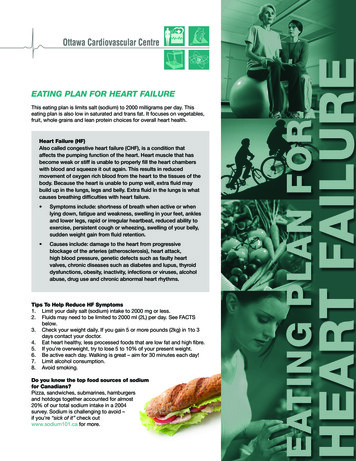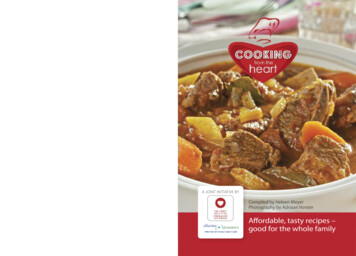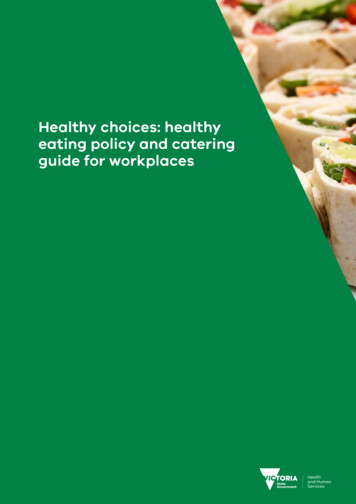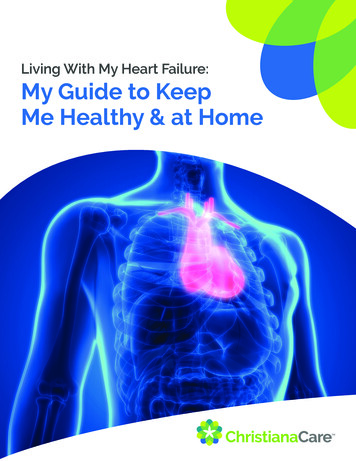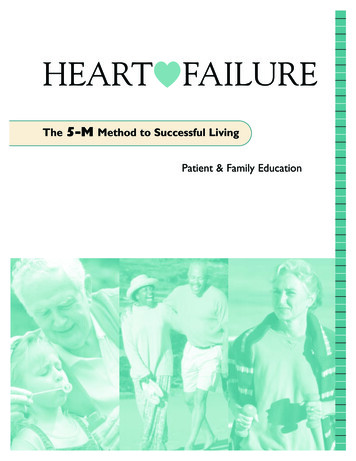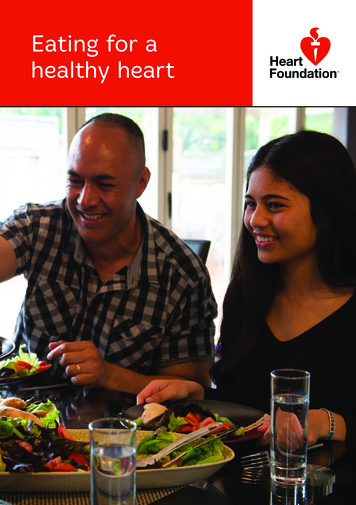
Transcription
Eating for ahealthy heart
Contentsto this Heart Foundation bookletYou have an important role to play in your heart health, and you can enjoyimproved heart health by changing what you eat.WelcomeIf you are ready to make changes to help look after your heart, then thisbooklet is for you. It suggests quick and simple changes you can make andshows how to check food labels.We recommend you work through this booklet with your nurse, doctor,dietitian or health professional, as they can provide you with individualisedinformation and advice.Heart-healthy eatingWhy change to heart-healthy eating? . 4Nine steps to heart-healthy eating . 5What is the Healthy heart? . 6Foods close to how they are found in nature. 11Vegetables and fruit. 13Grain foods and starchy vegetables. 17Legumes, fish, seafood, eggs, poultry and meat. 20Milk, yoghurt and cheese . 23Healthy oils, nuts and seeds. 26Drinks. 31Adding flavour without using salt and sugar . 34My checklistAfter reading through this booklet, you should be able to check offthe following statements:I know what foods are heart-healthyWhat to cut back on . 37Tool kitLabel reading . 40Managing your weight . 42I know the amounts of heart-healthy foods I need to eatI have set personal goals to improve the way I eatHealthy snacking . 44Pantry and freezer staples on a budget. 46I know how to check food labelsMeal planner. 47I know how to plan my meals.Making a plan for change . 50 2018 Heart Foundation of New Zealand. All rights reserved. If you would like permission to reproduce infull or in part or have any queries, please contact info@heartfoundation.org.nzContentsWelcome
Why change to heart-healthy eating?Nine steps to heart-healthy eatingIf you already have heart disease, changing the balance of foods you eatcan lower your overall risk of heart attack and stroke, and improve yourheart health.We usually eat the way we do because we like it. That means it can be hardto change some of the things we do. So it’s important to be prepared.If you want to stop yourself getting heart disease, what you eat, how activeyou are, and being smoke-free can reduce your risk by as much as 80%.Even if you are on medications for raised cholesterol, raised blood pressure,diabetes or heart disease, following a heart-healthy eating pattern will helpto further lower your heart risk.Apart from the effect on your heart, you’ll also probably feel better, havemore energy, and it might even help your weight. A heart-healthy lifestyleinvolves healthy eating, maintaining a healthy body weight, enjoying regularphysical activity and not smoking.Try to make changes one step at a time. As you find new ways ofpreparing heart-healthy meals, you will find it easier to choose moreof the foods that reduce heart risk, and less of those that increaserisk.4Here are nine simple steps for heart-healthy eating to help you makechanges to what you eat to improve your heart health.1Share and enjoy meals with family and friends that focusmostly on foods close to how they are found in nature.2Include plenty of colourful non-starchy vegetables and/or fruitat every meal and for most snacks.3Choose foods with intact whole grains in place of refined grainproducts.4Include some legumes, fish or seafood, eggs, skinless poultryor lean meat at one or two meals each day.5Use mostly reduced-fat or low-fat milk or milk products (orcalcium-rich alternatives) every day.6Choose healthy oils, nuts and seeds instead of animal andcoconut fats.7Drink water to quench thirst, and limit sugary drinks andalcohol.8When preparing meals, snacks or drinks, use pepper, herbs,spices or fruit to add flavour rather than using salt or sugar.9Cut back on junk foods, takeaways and foods high in sugar,salt or saturated and trans fats.Heart-healthy eatingHeart-healthy eatingHeart-healthy eating5
What is the Healthy Heart?Similar types of food can be substituted for each other. For example, in ameal kūmara can be eaten instead of whole grain bread.There are different ways to follow a heart-healthy eating pattern, but thecommon themes are: plenty of vegetables and fruit some grain foods and starchy vegetables, legumes, fish, seafood, eggs,lean poultry and meat and reduced-fat milk, yoghurt and cheese, andhealthy oils, nuts and seeds cutting back on and mostly avoiding junk food, takeaways and foodshigh in saturated or trans fats, salt and sugar.eatmostHeart-healthy eatingThe Healthy Heart (page 7) shows proportionally how much of each typeof food to eat over a day or week. Balance your day’s eating between thedifferent types of food in roughly the proportions shown.vegetables& fruiteatsomegrain foods &There is no one thing that you do or don’t eat that makes youhealthy – it’s how it all fits together as a whole. That means youcan focus on the overall style, and getting the basics right, withoutfeeling guilty for the occasional indulgence.milk, yoghurt& cheesehealthy oils,nuts & seedsds orCUT BACK ON junk foods, takeaways & foo6translegumes, fish, seafood,eggs, poultry & meat&Remember, it’s your overall dietary style that matters most – thetotal package of what you eat.fatsstarchy vegetablesterautsadHeart-healthy eatingThe most important part of heart-healthy eating is balancing theproportions of foods you eat.ksdrinorltasr,gaunshihig7
Heart-healthy eatingBreakfastLunchDinnerSnacks / otherAs well as the type of food, it’s also important to eat the right amount offood.Follow the proportions in the Healthy Heart to guide what you eat over aday. Eat a variety of foods to get a range of nutrients. Similar types of food can be substituted for each other. Eat regular meals with the right amount of food, so you feel satisfied, notfull. Use a smaller sized plate. Put leftovers in the fridge and take them for lunch the next day. Using your hand can be a simple way to check the size of your foodportions on your plate – refer to the next page.Heart-healthy eatingThink about what you eat over a day.How does what you eat compare to the Healthy Heart?cut back onjunk food &takeaways89
Heart-healthy eatingUsingyourownbe s.servingupbeforsomeoneelse,use ,usethesizeofportions. When serving up for someone else, use the size oftheirtheirhand.hand.Components of a mealComponentsComponentsofa aamealmealComponentsofofmealvegetables -starchy)Your two hands cupped together is a good guide for the amountYourtwohandscuppedisisa ideforforthetheamountamountof non-starchy vegetableslike hyvegetableslikecarrots,broccolicauliflower,you should include at your meal. Include more, if you Tip – choose vegetables from all the colours of the ftherainbow.Each colour provides a different range of nutrients.EachEachcolourcolourprovidesprovidesa ts.Grain foods and starchy vegetables or etablesvegetablesororlegumeslegumesA portion of grain foods and starchy vegetables is the size of your hesizesizeofofyouryourclosedfist. This group includes foods like potato, taro, r a bread roll. A portion of legumes is also the size of your closed fist.orora losedfist.fist.Legumesincludechickpeas,lentils ckpeas,lentilslentilsandandbeans.beans.Tip – if you want more than one grain food or starchy vegetable in your meal,Tipmore thanonegrainfoodororstarchyvegetable ininyourmeal,Tip– –if eofmoreeach thanone sototalportionis the vegetablesize of your yourfist. osothethetotaltotalportionportionis The whole of your hand is a good portion guide for a piece of fish.TheThewholewholeofofyouryourhandhandisisa agoodgoodportionportionguideguideforfora apiecepieceofoffish.fish.Tip – your whole hand is about the size of one fish fillet, which is llet,whichTip a– meal.your whole hand is about the size of one fish fillet, whichisisenoughenoughforforameal.for a meal.Poultry or meatPoultryPoultryorormeatmeatThe palm of your hand is a guide for a portion of red meat, chicken or pork.ThepalmofyourThe palm of yourhandhandisisa aguideguideforfora rorpork.pork.Tip – the thickness of the meat should be about the same thickness as thicknessastheTip – oftheyourthicknesspalmhand. of the meat should be about the same thickness as sSnacks10vegetables (non-starchy), fruit or ),fruitfruitorornutsnutsA single portion of vegetables, fruit or nuts is what fits into the palmAAsingleportionofvegetables,fruitorportion of vegetables, fruit lmofsingleyour hand.ofofyourhand.your hand.Tip – this is a good size for your snacks.TipTip– –thisthisisisa agoodgoodsizesizeforforyouryoursnacks.snacks.Nine steps to heart-healthy eatingStep 1. Share and enjoy regular meals with familyand friends that focus mostly on foods close tohow they are found in natureNine steps to heart-healthy ionsUsing your own hand can be an easy way to check the size of yourHealthy eating is more than simply eating healthy food. Sharing mealswith your family and friends can increase your enjoyment of food andencourages you to eat mindfully, rather than being distracted by TV, adevice or the world rushing around you.If you sit down to eat a meal, and eat slowly, you are more likely to feelfull before you have over-eaten.Having regular meals every day can provide a healthy balance of foods andnutrients. Select dishes that encourage you to eat foods that are close tohow they are found in nature.Foods close to nature: foods that are in their natural state suchas fresh vegetables and fruit, legumes, nuts and seeds, eggs, fish,chicken and lean red meat.Some foods like whole grain bread, milk and canned vegetableshave been through some processing, however most of the nutritionalbenefits remain and they are still a heart-healthy option.Highly-processed foods: tend to be low in fibre, vitamins, mineralsand phytonutrients (which are natural compounds produced byplants). These foods often contain added saturated fat, sugar and/orsalt.11
Step 2. Include plenty of colourful non-starchyvegetables and/or fruit at every meal and formost snacksNine steps to heart-healthy eatingNine steps to heart-healthy eatingMeal planningA heart-healthy meal can be made up of the following parts: colourful non-starchy vegetables and/or fruit grain foods or starchy vegetables – these include whole grainbread, oats, barley, brown rice, pasta, quinoa, potato, taro, kūmara,corn, cassava or green banana legumes, fish, seafood, eggs, skinned poultry and lean meat;reduced-fat milk or milk products healthy vegetable oils, nuts, seeds or avocado. Alternative spreadsinclude hummus, pesto or margarine spread.Flavourings are optional – herbs, spices are your best choice to addflavour as they don’t usually include any added sugar or salt.eat mostvegetables& fruitKia kaha te kai ngā hua whenua me ngā hua rākauVegetables and fruit are full of vitamins, minerals and fibre. These keep ourbody and brain working properly and are protective against poor health.When selecting sauces, relishes, or other spreads, pay closeattention to the food labels (see page 40) – less is best when itcomes to the three s’s (saturated fat, sugar and salt).Eating at least five serves (400g) of vegetables and fruit each day has beenassociated with lower rates of heart disease, cancer and obesity, and lowercholesterol and blood pressure.Eating plenty of foods with lower energy density, like non-starchy vegetablesand fruit, can help manage body weight because we fill up on foods withfewer calories. If we consume too much energy, our body stores the fuel,leading to weight gain.What proportion of your shopping trolley is vegetables and fruit?Potatoes, kūmara, corn, yams, cassava/tapioca, green banana andtaro are not included under ‘vegetables’ because they are in the‘Grain foods and starchy vegetables’ group (next section). This isbecause they have more starch and kilojoules per serving thanother vegetables.1213
Nine steps to heart-healthy eatingA serve is ½ cup of cooked vegetables or 1 cup of raw vegetabes, 1 carrot, 1medium apple, 2-3 small apricots or plums, ½ cup of canned (in natural juice)or frozen fruit.Add more Add one more vegetable or fruit to a meal or snack.How many serves should I eat? Have vegetables and/or fruit at every meal. For general health: eat 5 serves a day (3 serves of vegetables and 2serves of fruit). Fruit tastes great with breakfast, as an easily portable and affordablesnack, or instead of dessert. For heart health: aim to eat at least 3-4 serves each day of vegetables,and 3-4 serves of fruit. Vegetables add flavour and goodness, e.g. add lettuce and tomato to asandwich; or serve half a plate of vegetables with dinner. For people with diabetes: fruit may need to be limited and spread acrossthe day. Fruit size matters, e.g. choose a bobby banana rather than alarge one. Choose vegetables and fruit in a variety of colours to get a wide rangeof nutrients. Fresh, frozen and canned all count towards your recommended serves. Around 40% of the food in your weekly shopping trolley should bevegetables and fruit.What does 7-8 servings look like?Breakfast: 1 kiwifruit on cereal or 1 omelette with ½ cup of spinach andmushroomsLunch: Salad or coleslaw with dressing or 1 large tomato in a sandwich,1 peachNine steps to heart-healthy eatingMake a change – vegetables and fruitWhat is a serve?Healthier cooking styles For variety try steaming, stir-frying, baking, grilling or microwaving.Dinner: 1 cup of cooked green vegetables, ½ cup of cooked orange or redvegetablesFood to goSnacks: 1 carrot with hummus, 1 orange Grapes, vegetable sticks or cherry tomatoes make easy on-the-gosnacks.Vegetables and fruit should often be eaten instead of other foods,rather than in addition. So swap a muffin for an apple, or eat a bitless meat and add another vegetable at dinner.Frozen veges retain most of their nutritional value and are a cheapway of bulking out a meal. They also minimise waste.Vegetables and fruit are often cheaper at fruit and vegetable stores,Asian food shops or local markets.1415
Buy fruit and vegetables in season, or use frozen or canned varieties.Look for varieties lower in sugar and/or salt. Have double servings of cheaper varieties of vegetables such ascabbage, pumpkin, onions or canned tomatoes. Frozen veges are good for you and minimise any waste. A can of tomatoes can extend a meal. Trade excess seasonal fruit with neighbours. Buy vegetables that store well (kūmara, pumpkin) when they arecheaper. Adding grated vegetables can add flavour and texture and extendmost meat dishes. Find a good local fruit and vegetable shop or local market.Fruit and vegetables might seem expensive, but they’re not whenyou compare like with like. An apple at 3.99/kg is cheaper thanpotato chips at 10.60/kg (based on 1.59 for 150g).Step 3. Choose intact whole grains in place ofrefined grain productsNine steps to heart-healthy eatingNine steps to heart-healthy eatingSave dollarseat somegrain foods &starchy vegetablesKia āhua nui te kai parāoa, hua patakai, hua kano, huawhenua māngaroGrain foods and starchy vegetables are a good source of carbohydrate,which provides energy to fuel the body and brain. This type of food includesstarchy vegetables because of their high carbohydrate content. Grain foodsand starchy vegetables are a good source of fibre, vitamins and minerals.Choose whole grain and high-fibre carbohydrate foods as these areprotective against heart disease. Fibre helps the bowels work properly andimproves cholesterol and glucose levels.Which foods fit here?Grain foods: oats, barley, brown rice, whole grain bread, quinoa, buckwheat,millet, whole grain wraps, rēwena, chapatti, roti, breakfast cereals, tapioca,sago, amaranth, congee.Starchy veges: potato, Māori potatoes, kūmara, corn, parsnip, yams, taro,green banana, cassava.1617
A whole grain food is one with the words ‘whole’, ‘whole grain’, ‘oats’, ‘oatbran’, ‘bran’, ‘kibbled wheat’, ‘rye’, or ‘barley’ near the beginning of theingredients list, or one which has been less-refined e.g. quinoa, buckwheat,millet, brown rice.The best whole grains are those that contain the intact grain. This is whereyou can see visible chunks of grain, rather than the grain being ground orcrushed.Refined carbohydrates (e.g. white bread, white flour, sugar, bakery items, lowfibre cereals) differ from whole grains. They have been heavily processed andcontain fewer nutrients, less naturally occurring fibre, and their energy is usedup quickly. They do not have heart health benefits.Products can still call themselves whole grain even if the intactgrain has been crushed or ground.What is a serve?A serve of whole grain is 1 slice of whole grain bread, ½ whole grain roll, ½cup cooked porridge, ⅓ cup cooked brown rice or wholemeal pasta or naturalmuesli. A serve of starchy vegetables is 1 small potato or 1 small round of taro.Make a change – grain foods and starchy vegetablesShop smart About a quarter of the weekly shopping trolley should be wholegrain foods and starchy vegetables. Choose brown rice over white rice and whole grain bread overwhite bread. Choose whole grain foods which contain the intact grain, e.g. oats,brown rice or barley. Choose whole grain and high fibre breakfast cereals, e.g. traditionaloats, whole wheat biscuits or bran flakes. Use mostly wholemeal flour when making bread, chapatis, roti orrēwena.Nine steps to heart-healthy eatingNine steps to heart-healthy eatingWhat is an intact whole grain?Size really does matter At any meal, eat no more than a fist-sized portion of these foods. If you are eating more than one starchy food at a meal, reduce thesize of each one so that the total portion of both foods is no morethan the size of your fist.Try something differentHow many serves should I eat? Try different style breads with cracked grains or seeds. For general and heart health: eat 3 serves of whole grains a day. There arelikely to be greater benefits with higher intakes. Try brown rice, wholemeal pasta, cooked barley, cracked or bulghurwheat. For people with diabetes: have some carbohydrate foods at each meal,but not too much or it will raise blood glucose levels too high. Keep the skins on starchy vegetables such as potato and kūmara.The skins contain fibre and many nutrients.What does 3 servings of whole grains a day look like?Breakfast: ⅓ cup of natural muesliLunch: 1 slice of whole grain breadDinner: ⅓ cup of brown rice or wholemeal pasta1819
eat somelegumes, fish, seafood,eggs, poultry & meatKia āhua nui te kai ika, mīti, heihei, rekiumu, hēkiThis food group is a good source of protein, which the body uses forgrowth and repair. It also supplies iron, zinc and B vitamins. Eating legumes,fish (especially oily fish) and seafood also helps to support a healthy heart.Legumes are dried peas and beans also known as pulses and come in avariety of shapes and colours. There are many different types includingchickpeas, lentils, mung beans, red kidney beans, soybeans, pinto beans,split peas, adzuki beans and cannellini beans. They can either be soakedand cooked from dry, or bought pre-cooked in cans.Legumes are a common part of many food cultures around the world,e.g. Mediterranean, Turkish, African, Asian and South American.Nine steps to heart-healthy eatingNine steps to heart-healthy eatingStep 4. Include some legumes, fish, seafood,eggs, poultry or meat each dayCheck out the free Heart Foundation e-cookbook Full o’ Beans atheartfoundation.org.nzWhat is a serve?A serve is equal to: 1 cup cooked dried beans or split peas ½ cup cooked soy beans, tofu or tempeh 2 small fish fillets, sardines, 150g tuna, 85 - 95g salmon 2 eggs 1 small skinned chicken breast 2 slices cooked lean meat, 1 small lean steak (100g), ½ cup leanmince.How many serves should I eat? For general health: eat 1-2 serves per day. For heart health: eat legumes 4-5 times each week, eat fish 2 timesa week (preferably oily), small piece of chicken or lean meat (up to 1to 1 ½ servings per day) or vegetarian alternative.Fish is a great alternative to meat, and oily fish has the benefit of providingmore heart-healthy omega-3 fats. Oily fish includes: mackerel, sardines,salmon, kahawai, pilchards, silver warehou and herring. Canned fish canalso be an affordable option. If you don’t eat fish, you can still obtain hearthealthy fats from nuts, seeds, vegetable oils and spreads.Animal foods can be high in saturated fat. Reducing saturated fat andreplacing it with unsaturated fats improves cholesterol levels, a risk factorfor heart disease. So when choosing meat or chicken, choose lean cuts orremove the fat. On red meat, this is the white fat and on chicken, the skin.Limit the amounts of processed meats and sausages eaten, as the fat ishidden. Processed meats can also be high in salt, which can raise bloodpressure.20Those who are at increased risk of heart disease can eat up to sixeggs per week as part of a heart-healthy diet.21
Nine steps to heart-healthy eatingGet full of beans Add legumes to meals and dishes for variety. For convenience, usecanned varieties – for example canned chickpeas, kidney beans ormixed bean salads. Add legumes to soups, curries or casseroles, make lentil patties oradd them to meat patties. This will also help to reduce the amount ofmeat used. Lentils cook more quickly than other dried beans. Baked beans are a cheap, filling and nutritious way to eat morelegumes. Check food labels and choose those lower in sugar and salt.Include fish – See the Best Fish Guide (bestfishguide.org.nz) forsustainable choices. Aim to eat at least 2-3 servings of fish each week, especially oily fish. Bake or grill fish with a sprinkle of pepper, herbs and lemon.Keep meat lean22 Choose fresh varieties of fish, poultry and meat more often than preprepared types Remove visible white fat or skin before adding meat to stir-fries, stews,soups or boil-ups. Scoop the fat off casseroles, stews and stocks – this is easier if thefood is chilled first. Cook and drain the fat off mince before adding to other ingredients. Change the water half way through a boil-up, or skim off the fat. Heat a can of corned beef in hot water, then drain off the fat. Use healthy sandwich fillings instead of processed meats, e.g. cannedfish, roast chicken, peanut butter, falafels, hummus, boiled egg,reduced-fat cheese and lots of salad vegetables. Cook meat cuts on a rack when grilling, barbequing, roasting andbaking.Step 5. Use mostly reduced-fat or low-fat milkor milk products (or calcium-rich alternatives)every dayNine steps to heart-healthy eatingMake a change – legumes, fish, seafood, poultry.eat somemilk, yoghurt& cheeseKia āhua nui te kai miraka, miraka tepe, tīhiThis food group is a good source of calcium, protein and some carbohydrate.Calcium is important for bone health.While two-thirds of the fat in milk products is saturated fat, dairy fat might notbe as harmful as once thought. However, given most people in New Zealandare eating more saturated fat than recommended, switching to mostlyreduced-fat varieties or using smaller amounts of higher fat dairy products isbeneficial.If you are following a heart-healthy way of eating, and your diet is relativelylow in total saturated fat (or dairy only makes up a small part of your diet),then the type of milk (full-fat, reduced-fat, or fat-free) you use is probably lessimportant. However the evidence remains that it is better for our hearts toreplace saturated fats with unsaturated fats.Yoghurts and milk drinks are often sweetened. Choose unsweetenedvarieties to limit your intake of added sugar.Do you choose reduced-fat milk and yoghurt?23
When choosing plant-based milks like soy, almond, rice and coconutmilks choose reduced-fat versions and search for milks that are calciumfortified. Also note that many plant-based milks (apart from soy milk) haveless protein than cow’s milk.What is a serve?A serving is 1 glass (250mL) milk, 1 pottle (150g) yoghurt, 20g or 2cmcube or 3 tablespoons grated hard cheese (e.g. cheddar or tasty),30g or 3cm cube semi-hard cheese (e.g. camembert, brie, Edam, feta,mozzarella or reduced-fat cheeses).TastyMildCream cheeseColbyBlue vein*Processed cheeseslices*EdamNobleCheddar (light)Feta*CamembertMozzarellaCream cheese(reduced-fat)Cheese spread(light)RicottaProcessed cheeseslices (reduced-fat)*Type of cheese* Contains more than 800mg/100g sodium For general health: eat at least 2 serves per day. For heart health: eat 2-3 servings each day (or replace with calciumfortified soy products if milk isn’t used). For people with diabetes: the natural sugars (and any added sugars)in milk and yoghurt contribute to carbohydrate intake.Gradually change the milk you use to green, yellow or lite blue cap.Say cheese Use only small amounts of cheese. If you’re after a reduced-fat cheese which still packs a punch offlavour, try using noble cheese. Ithas the taste of cheddar but evenless fat than Edam. Have cottage cheese insandwiches.Check sweetness Try unsweetened yoghurt with fresh fruit. Choose milk products that have less or no sugars added.Watch toppings and drinks Keep cream, sour cream, cream cheese, and crème fraîche forspecial occasions only. Instead of regular, sour or reduced cream, use cottage cheese, lowfat sour cream, European-style yoghurt or plain yoghurt on bakedpotatoes and in dips, or evaporated cream in sauces. Substitute full-fat café coffee drinks, milkshakes, smoothies, dairyfoods and desserts with trim milk drinks and low-fat yoghurts.How many serves should I eat?24Nine steps to heart-healthy eatingg/100gChoose mostly reduced-fat or trim milkCottage cheeseNine steps to heart-healthy eatingMake a change – milk, yoghurt and cheeseCottage cheese(light)403530252015105025
eat someWhat do you mean by healthy oils?Not all oils are created equal. Palm oil and coconut oil contain high levelsof saturated fat which can increase your risk of heart disease. While theseoils are better for your heart when compared to butter, there are far betterplant oils for your heart, such as olive oil.Nine steps to heart-healthy eatingNine steps to heart-healthy eatingStep 6. Choose healthy oils, nuts and seedsinstead of animal and coconut fatsUnrefined oils, or those which are called ‘cold-pressed’ or ‘extra virgin’,have undergone very little processing. Therefore these oils have higherlevels of many beneficial compounds, such as antioxidants.healthy oils,nuts & seedsThis food group contains vegetable oils, nuts, seeds, avocado, olives andspreads based on these foods.Nuts, seeds, avocado, olives and healthy oils (other than palm and coconutoil) contain heart-healthy poly and monounsaturated fats. They are a betterchoice than foods high in animal fats such as butter, cream and meat fats.Polyunsaturated fats are essential nutrients so it is important to regularlychoose some foods rich in these fats. Foods rich in polyunsaturated andmonounsaturated fats help to reduce ‘bad’ cholesterol – low densitylipoprotein (LDL) and increase the ‘good’ cholesterol – high densitylipoprotein (HDL) in the blood.Swapping saturated fats for heart-healthy fats improves yourcholesterol. 26Replacing saturated fat with polyunsaturated
heart health. If you want to stop yourself getting heart disease, what you eat, how active you are, and being smoke-free can reduce your risk by as much as 80%. Even if you are on medications for raised cholesterol, raised blood pressure, diabetes or heart disease, following a heart-healthy eating pattern will help to further lower your heart risk.
